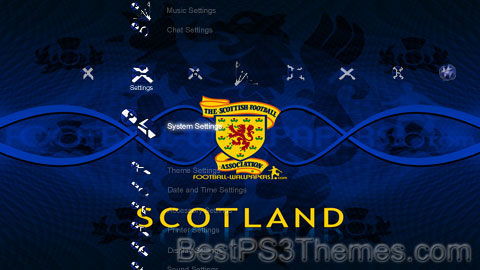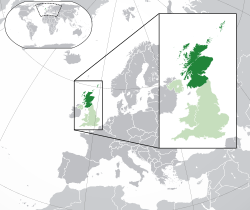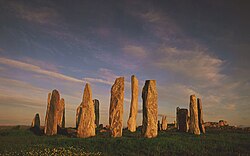Scotland theme by PDSangster
Download: Scotland.p3t

(1 background)
Scotland | |
|---|---|
| Anthem: various, predominantly "Flower of Scotland" | |
 Location of Scotland (dark green) – in Europe (green & dark grey) | |
| Status | Country |
| Capital | Edinburgh 55°57′11″N 3°11′20″W / 55.95306°N 3.18889°W |
| Largest city | Glasgow 55°51′40″N 4°15′00″W / 55.86111°N 4.25000°W |
| Ethnic groups | |
| Religion (2022)[1] | List
|
| Demonym(s) | Scottish • Scots |
| Government | Devolved parliamentary legislature within a constitutional monarchy |
• Monarch | Charles III |
| John Swinney | |
| Parliament of the United Kingdom | |
| • Secretary of State | Alister Jack |
| • House of Commons | 59 MPs (of 650) |
| Legislature | Scottish Parliament |
| Formation | |
| 9th century (traditionally 843) | |
| 17 March 1328 | |
| 3 October 1357[2] | |
| 1 May 1707 | |
| 19 November 1998 | |
| Area | |
• Total[a] | 80,231 km2 (30,977 sq mi)[3] |
• Land[b] | 77,901 km2 (30,078 sq mi)[3] |
| Population | |
• 2022 census | |
• Density | 70/km2 (181.3/sq mi)[4] |
| GVA | 2022 estimate |
| • Total | £165.7 billion |
| • Per capita | £30,419[5] |
| GDP (nominal) | 2022 estimate |
• Total | £211.7 billion |
• Per capita | £38,622[6][c] |
| Gini (2020–23) | medium |
| HDI (2021) | very high |
| Currency | Pound sterling (GBP; £) |
| Time zone | UTC+0 (GMT) |
• Summer (DST) | UTC+1 (BST) |
| Date format | dd/mm/yyyy (AD) |
| Driving side | left |
| Calling code | +44 |
| ISO 3166 code | GB-SCT |
| Internet TLD | .scot[d] |
Scotland (Scots: Scotland; Scottish Gaelic: Alba) is a country that is part of the United Kingdom. It contains nearly one-third of the United Kingdom's land area, consisting of the northern part of the island of Great Britain and more than 790 adjacent islands, principally in the archipelagos of the Hebrides and the Northern Isles. To the south-east, Scotland has its only land border, which is 96 miles (154 km) long and shared with England; the country is surrounded by the Atlantic Ocean to the north and west, the North Sea to the north-east and east, and the Irish Sea to the south. The population in 2022 was 5,439,842 and accounts for 8% of the population of the UK.[9] Edinburgh is the capital and Glasgow is the largest of the cities of Scotland.
The Kingdom of Scotland emerged as an independent sovereign state in the 9th century. In 1603, James VI inherited the Kingdom of England and the Kingdom of Ireland, forming a personal union of the three kingdoms. On 1 May 1707 Scotland and England combined to create the new Kingdom of Great Britain,[10][11] with the Parliament of Scotland subsumed into the Parliament of Great Britain. In 1999 a Scottish Parliament was re-established, and has devolved authority over many areas of domestic policy.[12] The country has a distinct legal system, educational system, and religious history from the rest of the UK, which have all contributed to the continuation of Scottish culture and national identity.[13] Scottish English and Scots are the most widely spoken languages in the country, existing on a dialect continuum with each other.[14] Scottish Gaelic speakers can be found all over Scotland, however the language is largely spoken natively by communities within the Hebrides.[15] The number of Gaelic speakers numbers less than 2% of the total population, though state-sponsored revitalisation attempts have led to a growing community of second language speakers.[16]
The mainland of Scotland is broadly divided into three regions: the Highlands, a mountainous region in the north and north-west; the Lowlands, a flatter plain across the centre of the country; and the Southern Uplands, a hilly region along the southern border. The Highlands are the most mountainous region of the British Isles and contain its highest peak, Ben Nevis, at 4,413 feet (1,345 m).[9] The region also contains many lakes, called lochs; the term is also applied to the many saltwater inlets along the country's deeply indented western coastline. The geography of the many islands is varied. Some, such as Mull and Skye, are noted for their mountainous terrain, while the likes of Tiree and Coll are much flatter.
Etymology[edit]
Scotland comes from Scoti, the Latin name for the Gaels.[17] Philip Freeman has speculated on the likelihood of a group of raiders adopting a name from an Indo-European root, *skot, citing the parallel in Greek skotos (σκότος), meaning "darkness, gloom".[18] The Late Latin word Scotia ("land of the Gaels") was initially used to refer to Ireland,[19] and likewise in early Old English Scotland was used for Ireland.[20] By the 11th century at the latest, Scotia was being used to refer to (Gaelic-speaking) Scotland north of the River Forth, alongside Albania or Albany, both derived from the Gaelic Alba.[21] The use of the words Scots and Scotland to encompass all of what is now Scotland became common in the Late Middle Ages.[10]
History[edit]
Prehistory[edit]
Prehistoric Scotland, before the arrival of the Roman Empire, was culturally divergent.[22]
Repeated glaciations, which covered the entire land mass of modern Scotland, destroyed any traces of human habitation that may have existed before the Mesolithic period. It is believed the first post-glacial groups of hunter-gatherers arrived in Scotland around 12,800 years ago, as the ice sheet retreated after the last glaciation.[23] At the time, Scotland was covered in forests, had more bog-land, and the main form of transport was by water.[24] These settlers began building the first known permanent houses on Scottish soil around 9,500 years ago, and the first villages around 6,000 years ago. The well-preserved village of Skara Brae on the mainland of Orkney dates from this period. Neolithic habitation, burial, and ritual sites are particularly common and well preserved in the Northern Isles and Western Isles, where a lack of trees led to most structures being built of local stone.[25] Evidence of sophisticated pre-Christian belief systems is demonstrated by sites such as the Callanish Stones on Lewis and the Maes Howe on Orkney, which were built in the third millennium BC.[26]: 38
Early history[edit]


The first written reference to Scotland was in 320 BC by Greek sailor Pytheas, who called the northern tip of Britain "Orcas", the source of the name of the Orkney islands.[24]: 10
Most of modern Scotland was not incorporated into the Roman Empire, and Roman control over parts of the area fluctuated over a rather short period. The first Roman incursion into Scotland was in 79 AD, when Agricola invaded Scotland; he defeated a Caledonian army at the Battle of Mons Graupius in 83 AD.[24]: 12 After the Roman victory, Roman forts were briefly set along the Gask Ridge close to the Highland line, but by three years after the battle, the Roman armies had withdrawn to the Southern Uplands.[27] Remains of Roman forts established in the 1st century have been found as far north as the Moray Firth.[28] By the reign of the Roman emperor Trajan (r. 98–117), Roman control had lapsed to Britain south of a line between the River Tyne and the Solway Firth.[29] Along this line, Trajan's successor Hadrian (r. 117–138) erected Hadrian's Wall in northern England[24]: 12 and the Limes Britannicus became the northern border of the Roman Empire.[30][31] The Roman influence on the southern part of the country was considerable, and they introduced Christianity to Scotland.[24]: 13–14 [26]: 38
The Antonine Wall was built from 142 at the order of Hadrian's successor Antoninus Pius (r. 138–161), defending the Roman part of Scotland from the unadministered part of the island, north of a line between the Firth of Clyde and the Firth of Forth.[32] The Roman invasion of Caledonia 208–210 was undertaken by emperors of the imperial Severan dynasty in response to the breaking of a treaty by the Caledonians in 197,[28] but permanent conquest of the whole of Great Britain was forestalled by Roman forces becoming bogged down in punishing guerrilla warfare and the death of the senior emperor Septimius Severus (r. 193–211) at Eboracum (York) after he was taken ill while on campaign. Although forts erected by the Roman army in the Severan campaign were placed near those established by Agricola and were clustered at the mouths of the glens in the Highlands, the Caledonians were again in revolt in 210–211 and these were overrun.[28]
To the Roman historians Tacitus and Cassius Dio, the Scottish Highlands and the area north of the River Forth was called Caledonia.[28] According to Cassius Dio, the inhabitants of Caledonia were the Caledonians and the Maeatae.[28] Other ancient authors used the adjective "Caledonian" to mean anywhere in northern or inland Britain, often mentioning the region's people and animals, its cold climate, its pearls, and a noteworthy region of wooded hills (Latin: saltus) which the 2nd century AD Roman philosopher Ptolemy, in his Geography, described as being south-west of the Beauly Firth.[28] The name Caledonia is echoed in the place names of Dunkeld, Rohallion, and Schiehallion.[28]
The Great Conspiracy constituted a seemingly coordinated invasion against Roman rule in Britain in the later 4th century, which included the participation of the Gaelic Scoti and the Caledonians, who were then known as Picts by the Romans. This was defeated by the comes Theodosius; but Roman military government was withdrawn from the island altogether by the early 5th century, resulting in the


